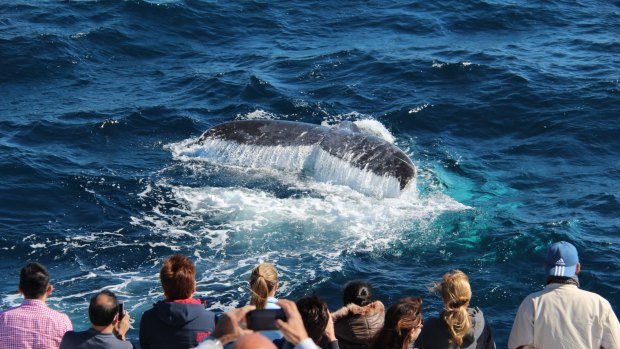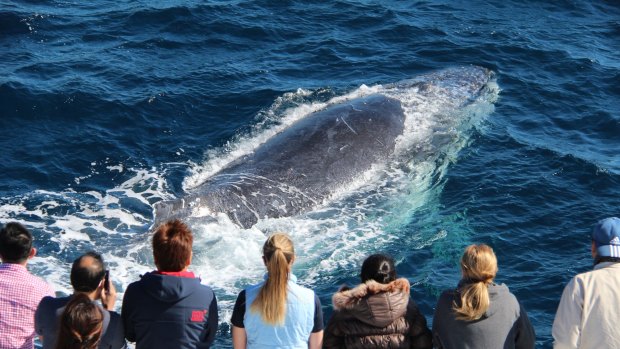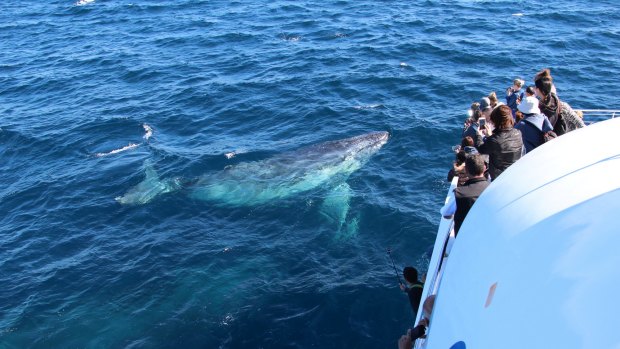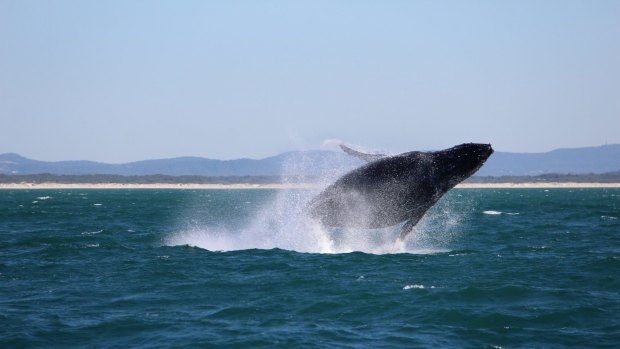This was published 7 years ago
Whale watching brings more than half a million tourists to Queensland
By Nathanael Cooper
Nature's largest beasts have begun their majestic journey from Antarctica to the Great Barrier Reef and watching on will be hundreds of thousands of tourists.
The annual humpback whale migration has become a major tourism draw card with people travelling from all over the world to have up-close encounters with the giants of the sea.
Whether it be through chartered whale watching trips, recreational vessels or passive opportunities to see the creatures from headlands and beaches, it is a massive money spinner for tourism operators.
Figures from Tourism and Events Queensland show 164,000 domestic visitors went whale or dolphin watching in Queensland in the 12 months to March this year. But it is international visitors who seem to really love the experience.

More than half a million international visitors try whale watching while in Queensland.Credit: Sea World Whale Watch
585,000 foreign tourists engaged in whale watching activities in the same period, a staggering number of people making it part of their Queensland holiday.
The whales make their way along the Queensland coast in June as they head toward the warmer waters of the Great Barrier Reef.
Earlier this month the Quandamooka people officially welcomed the whales at a ceremony on Tangalooma Beach a traditional sign the animals are arriving.
Tourism operators up and down the coast make the most of their visit with hundreds of specialist whale watching journeys taking place every day.

More than half a million international visitors try whale watching while in Queensland.Credit: Sea World Whale Watch
In Hervey Bay the humpback whales tend to stop for a spell to teach their young calves survival skills before continuing on their journey.
But there are opportunities to see the whales right along the coast - and not just humpbacks.

More than half a million international visitors try whale watching while in Queensland.Credit: Sea World Whale Watch
Director of Marine Sciences at Sea World on the Gold Coast, Trevor Long, said there were a variety of different kinds of whales that travel along the coast.
"Off the east coast we have predominantly humpbacks but you also see southern right whales, a lot of toothed whales and we will see some killer whales come through as well," he said.

More than half a million international visitors try whale watching while in Queensland.Credit: Sea World Whale Watch
Mr Long said the whale migration was vital for some communities along the coast.
"What whale watching does to many communities along the east coast is to provide a level of tourism and tourism dollars," he said.
But while the tourism element is important, he said the educational experience visitors receive when they meet the whales up close was even more valuable.
"I think what happens, when you are able to see something and use your sensory systems it gives you a greater appreciation," he said.
"Children, especially, get a love of animals from seeing them and that flows on to wanting to protect the animals and assist the environment."
For Sea World, the migration can be a busy time as they rush to treat injured animals and, occasionally, some beachings.
"We have been instrumental for many years assisting these animals," he said.
"They are often trapped in commercial fishing nets and buoys... I did my first rescue of a humpback whale in a fishing net in 1974, so we have been doing it for a long time.
"Sea World are the only people in the world that have ever been able to free these large animals when they have become beached and we will see more of that occur because as there's more animals there will be more incidents."
Mr Long said as exciting as it was for people to see the whales, it was essential that people heading out into the ocean to catch a glimpse, particularly recreational visitors, educate themselves before they go.
"Go online, look up whale watching guidelines and educate yourself to make sure you don't become a harassment to them," he said.
The whale watching seasons continues until November.